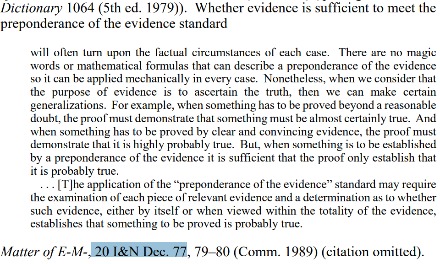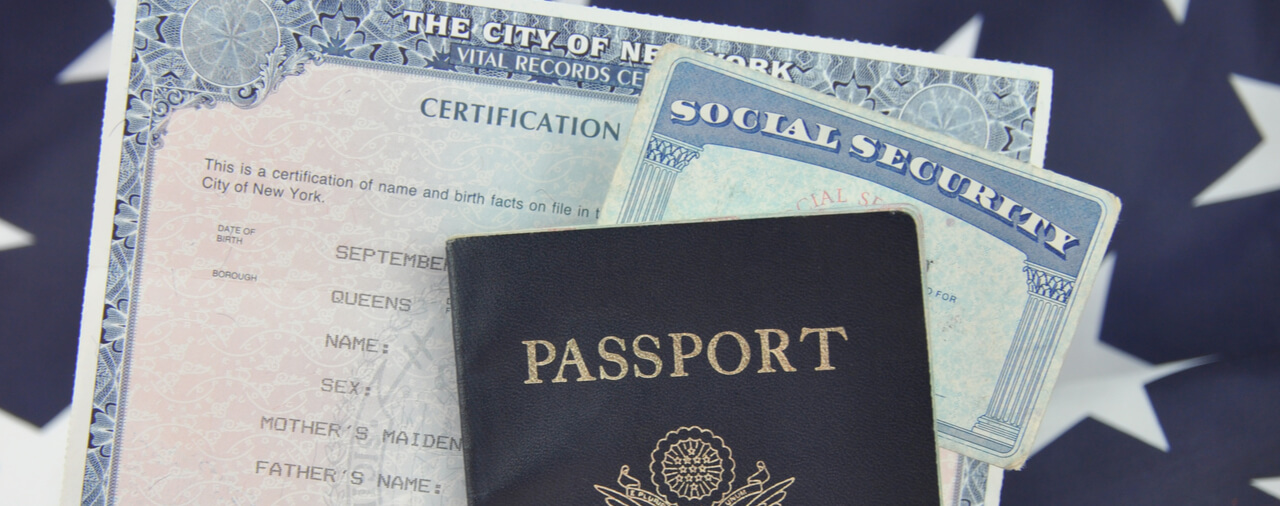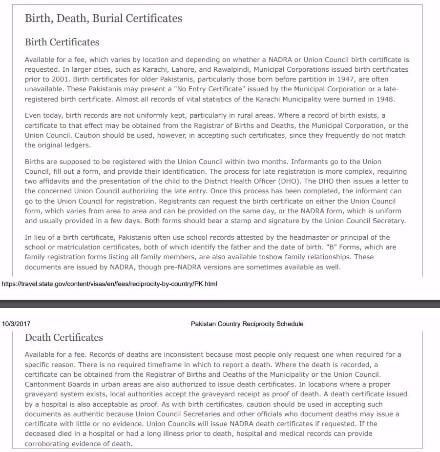- Introduction: Matter of Rehman, 27 I&N Dec. 124 (BIA 2017)
- Factual and Procedural History: 27 I&N Dec. at 124 (BIA 2017)
- Analysis and Conclusions: 27 I&N Dec. at 125-29 (BIA 2017)
- Standard — Preponderance of the Evidence: 27 I&N Dec. at 125
- Examining Primary Evidence: 27 I&N Dec. at 125-27
- Determining Whether Delayed Birth Certificate is Sufficiently Reliable to Establish Parentage: 27 I&N Dec. at 127
- Secondary Evidence: 27 I&N Dec. at 127-28
- Applying the Rules to the Instant Case: 27 I&N Dec. at 128-29
- Board’s Conclusion: 27 I&N Dec. at 129
- Conclusion
Introduction: Matter of Rehman, 27 I&N Dec. 124 (BIA 2017)
On September 20, 2017, the Board of Immigration Appeals (BIA) issued a published for precedent decision in the Matter of Rehman, 27 I&N Dec. 124 (BIA 2017). The case concerns determining whether a birth certificate that was not registered contemporaneously with a birth establishes a familial relationship by a preponderance of the evidence. The Board held that in determining whether such a birth certificate submitted by a petitioner establishes a familial relationship, adjudicators must consider the birth certificate itself, other evidence of record, and the circumstances of the case to determine if the petitioner sustained his or her burden.
In this article, we will example the factual and procedural history of the Matter of Rehman, the Board’s reasoning and decision, and what the new precedent means going forward.
For an article on a related issue, please see our discussion of Matter of Ruzku, 26 I&N Dec. 731 (BIA 2016), which examined sibling-to-sibling DNA test results as evidence for establishing familial relationships.
Factual and Procedural History: 27 I&N Dec. at 124 (BIA 2017)
The petitioner, a United States citizen, filed a family-based immigrant visa petition for his brother under section 203(a)(4) of the Immigration and Nationality Act (INA). In order to establish that the beneficiary was his brother, the petitioner submitted the beneficiary’s birth certificate. However, while the birth certificate indicated that the beneficiary was born in 1956, the certificate itself was registered in 1958. The Service Center Director adjudicating the petition denied it, finding specifically that the birth certificate submitted by the petitioner did not prove the beneficiary’s parentage because it was registered two years after his birth. Additionally, the Service Center Director found that the petitioner had not submitted sufficient secondary evidence to support the birth certificate in light of the delay in registration.
The respondent appealed from the Service Center Director’s denial to the BIA.
Analysis and Conclusions: 27 I&N Dec. at 125-29 (BIA 2017)
The Board’s task was to determine what sorts of factors should be considered in “assessing whether a petitioner has established a familial relationship by a preponderance of the evidence where a birth certificate submitted to prove the relationship reflects that it was not registered contemporaneously with the birth.” In short, the Board’s question was in a case when a petitioner submits a birth certificate relating to the beneficiary that was not registered at the same time as the birth, what evidence would be required in order to establish the required familial relationship. In the foregoing subsections, we will analyze the Board’s decision with each point in order.
Standard — Preponderance of the Evidence: 27 I&N Dec. at 125
The Board explained that, in visa petition proceedings, the burden of proof rests with the petitioner. The petitioner must sustain his or her burden by establishing the claimed relationship to the beneficiary by a “preponderance of the evidence.” The Board recently applied this same standard in the family-based petition context in Matter of Ruzku, 26 I&N Dec. 731, 731 (BIA 2016).
In Matter of Lemhammad, 20 I&N Dec. 316, 320 n.5 (BIA 1991), the Board quoted from the 5th edition of Black’s Law Dictionary in defining “preponderance of the evidence” as “evidence which as a whole shows that the fact sought to be proved is more probable than not.” In short, this means that, in the visa petition context, the petitioner must establish that it is more probable than not that the beneficiary is eligible for the benefit sought. Regarding the issue in the instant case, the petitioner was required to establish that it was more probable than not that the beneficiary was, in fact, his brother.
In Matter of E-M-, 20 I&N Dec. 77, 79-80 (Comm. 1989), the then-Immigration and Naturalization Service (INS) provided a clear precedential definition of “preponderance of the evidence.” We discuss this case in more detail in our full article [see article]. The Board quoted the following passage from the decision:

Matter of E-M- made clear that whether evidence is sufficient to meet the preponderance of the evidence standard in any specific case depends on the factual circumstances of the case. In assessing whether evidence meets the preponderance of the evidence standard, the question is whether the evidence establishes that the claim is, at a minimum, “probably true.” In assessing whether evidence establishes that a claim is “probably true,” the adjudicator may look at a piece of evidence in isolation or in the context of the totality of the evidence.
Examining Primary Evidence: 27 I&N Dec. at 125-27
The Board explained that, under regulations found in 8 C.F.R. 103.2(b) and 204(f)(1) (2017), a petitioner should submit primary evidence, if available, to establish a claimed family relationship in visa petition proceedings. Under 8 C.F.R. 204.2(g)(2)(i) (2017), in the context of establishing a sibling relationship, birth certificates showing a common parent is considered to be primary evidence. Primary evidence may be less available in cases arising from some countries than others. Accordingly, adjudicators are permitted to refer to the U.S. Department of State (DOS) Foreign Affairs Manual (FAM) Reciprocity Schedule in assessing what types of primary evidence may be available. Other evidence in the record may be considered if primary evidence is unavailable.
The Board next considered birth certificates as primary evidence in particular. In Matter of Bueno, 21 I&N Dec. 1029, 1032 (BIA 1997), the Board cited to its prior published decision in Matter of Ma, 20 I&N Dec. 394 (BIA 1991), in explaining that it had “been reluctant to accord delayed birth certificates the same weight we would give birth certificates issued at the time of birth.” The Board explained its reasoning in Matter of Serna, 16 I&N Dec. 643, 645 (BIA 1978), where it concluded that fraud is more likely in cases involving the delayed issuance of birth certificates than in cases involving birth certificates that are issued contemporaneously with the birth in question. However, the Board did not conclude in these prior decisions that a delayed birth certificate cannot be relied upon at all. In Matter of Serna, 16 I&N Dec. at 644-45, the Board noted that it would be “unjust” to penalize individuals merely for not being born in facilities were births were not officially registered. Accordingly, in Matter of Bueno, 21 I&N Dec. at 1033, the Board held that, while a delayed certificate is not conclusive evidence of a family relationship, it may “be evaluated in light of the other evidence of record and the circumstances of the case.”
The Board noted that the Service Center Director who rendered the decision against the petitioner in the instant case had issued “a pattern of decisions where [he] has determined that birth certificates registered 1 year or more after the birth are considered delayed.” The Board held that this standard has no basis in either the regulations or BIA precedent.
The Board explained that, in its previous cases, it has “considered the record as a whole to determine where there is sufficient evidence of a relationship” in cases where the petitioner relied upon a delayed birth certificate.
In both Matter of Bueno and Matter of Ma, the Board assessed delayed birth certificate cases. In Matter of Bueno, the petitioner relied upon a birth certificate that was registered 7 years after the birth of the beneficiary and 9 months prior to the filing of the petition. The Board concluded that additional evidence would be needed to establish the paternity of the beneficiary, and that an affidavit submitted by the petitioner was insufficient. In Matter of Ma, the petitioner submitted a Chinese notarial certificate issued 40 years after the birth of the beneficiary. The Board found that, while Chinese notarial certificates were generally reliable, the 40-year delay raised questions, and the Board concluded that the notarial certificate should be considered only in light of any supporting evidence that the petitioner could produce.
Citing to Matter of Bueno, 21 I&N Dec. at 1033, the Board explained that in considering whether a birth certificate is “delayed” and thus implicates fraud concerns, the “adjudicator must consider all the other evidence of record and the circumstances of the case to determine whether a petitioner has submitted sufficient reliable evidence to demonstrate the claimed familial relationship by a preponderance of the evidence.”
Determining Whether Delayed Birth Certificate is Sufficiently Reliable to Establish Parentage: 27 I&N Dec. at 127
The Board explained that even in cases where a birth certificate reflects that it was registered after the birth of the individual in question, an adjudicator may still determine, depending on the circumstances of the case, that the certificate is “sufficiently reliable to establish parentage…” In making such a determination, the Board held that an adjudicator “should consider all relevant factors.” To that effect, the Board provided the following non-exhaustive list of factors (quoted):
- Information in the FAM regarding the availability and reliability of birth registrations in the country of birth during the time period at issue;
- The length of time between the birth and the registration;
- Any credible explanation proffered by the petitioner at to the personal, societal, or historical circumstances that prevented a particular birth certificate from being registered contemporaneously, and any evidence in support of that explanation;
- Any credible explanation for why a particular birth certificate was lost or destroyed;
- Any evidence that the parental relationship was independently corroborated prior to the registration of the birth;
- The length of time between the birth registration and the filing of the visa petition; and
- Information regarding whether the document was based on facts that were contemporaneous with the birth or on facts that were more recently established.
However, as we discussed, a delayed birth certificate may be evaluated in light of all evidence submitted by the petitioner in determining whether the petitioner sustained his or her burden of proof. This means that a petitioner may meet the preponderance of the evidence standard with additional evidence even in cases where the adjudicator determines that the delayed birth certificate itself does not establish a family relationship ship under the preponderance of the evidence standard. We will explore secondary evidence for such cases in the next subsection.
Secondary Evidence: 27 I&N Dec. at 127-28
The Board explained that in cases where the adjudicator determines that a birth certificate is not sufficiently reliable to establish a familial relationship by a preponderance of all of the evidence in light of all of the circumstances, the adjudicator should move to consider the secondary evidence submitted by the petitioner. This is outlined in 8 C.F.R. 103.2(b)(2).
The Board explained that “[t]he regulations do not specify the secondary evidence to be considered in sibling petition cases like the one before us.” For guidance, the Board looked to the regulations in 8 C.F.R. 204.1(g)(2), which set forth the types of secondary evidence that a petitioner may submit to establish that he or she is a U.S. citizen or alien lawfully admitted for permanent residence. We discuss 8 C.F.R. 204.1(g)(2) in a separate and comprehensive article on site.
Relying upon 8 C.F.R. 204.1(g)(2) and (g)(2)(v) in particular, the Board provided the following non-exhaustive list of examples of secondary evidence that a petitioner may submit to establish his or her relationship with a sibling beneficiary (quoted):
- Governmental, medical, religious, school, financial, employment, insurance, or residential records that reflect the names of the parent(s) and child;
- Family photographs with notations indicating the persons photographed as well as the date and place they were taken;
- Correspondence, preferably with the original envelope, showing the date written and referring to the parent(s) of the child;
- Affidavits by persons who have personal knowledge of the birth; and
- The results of DNA testing conducted in a prescribed manner, as explained to the petitioner by the United States Citizenship and Immigration Services (USCIS).
The Board stated that due to advances in DNA testing, the USCIS should encourage petitioners to pursue this option. Please see our full article on Matter of Ruzku for a case related to this subject. In cases where a delayed birth certificate is found to be insufficient for meeting the petitioner’s burden, the Board took the position that the USCIS should provide a Request for Evidence with a detailed explanation of types of secondary evidence.
Accordingly, the Board agreed with the petitioner that all secondary evidence should be considered. However, the Board explained that it also agreed with the USCIS’s position in the case that “secondary evidence that was created contemporaneous with the birth will be most persuasive.”
Applying the Rules to the Instant Case: 27 I&N Dec. at 128-29
The Board explained that the beneficiary’s birth was registered when he was two years old. That made the birth certificate in the instant case less “delayed” than in the cases addressed in Matter of Ma and Matter of Bueno. Furthermore, the Board noted that, in the instant case, the petitioner filed the petition 52 years after the beneficiary’s birth was registered, whereas in Matter of Bueno, the petition was filed only nine months after the beneficiary’s birth was registered. Accordingly, the Board determined that based on these factors, there was a reduced risk of fraud in the instant case relative to the situation in Matter of Bueno.
Additionally, the Board noted that the Service Center Director in the instant case failed to give any indication that he had referred to the FAM regarding birth certificates from Pakistan. To this effect, the Board referenced the DOS’s Pakistan Country Reciprocity Schedule. The picture below is the section of the Reciprocity Schedule relating to birth certificates:
[Click image to view full size]
The Board noted that the FAM indicates that birth certificates for Pakistanis born shortly after 1947 may often be unavailable. The Board stated that the Service Center Director should have weighed this fact in considering the persuasiveness of the beneficiary’s birth certificate registered in 1958.
Board’s Conclusion: 27 I&N Dec. at 129
The Board remanded the case to the Service Center Director for application of the framework set forth in this decision. The Board instructed the Service Center Director to consider secondary evidence if the Director determines that the birth certificate alone is not sufficiently reliable.
Conclusion
When filing a family-based immigrant visa petition, the petitioner should consult with an experienced immigration attorney. An attorney will be able to evaluate all of the available evidence and determine how to best structure the immigrant visa petition based on case-specific circumstances.






